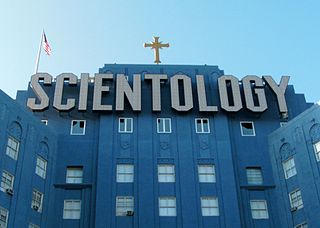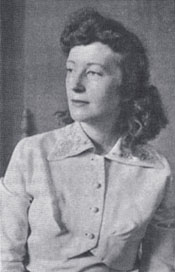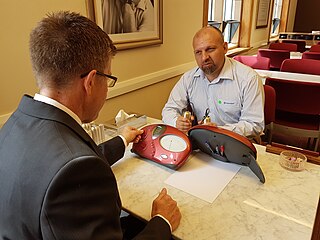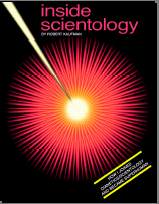
Lafayette Ronald Hubbard was an American author and the founder of Scientology. A prolific writer of pulp science fiction and fantasy novels in his early career, in 1950 he authored Dianetics: The Modern Science of Mental Health and established organizations to promote and practice Dianetics techniques. Hubbard created Scientology in 1952 after losing the intellectual rights to his literature on Dianetics in bankruptcy. He would lead the Church of Scientology, variously described as a cult, a new religious movement, or a business, until his death in 1986.

Xenu, also called Xemu, is a figure in the Church of Scientology's secret "Advanced Technology", a sacred and esoteric teaching. According to the "Technology", Xenu was the extraterrestrial ruler of a "Galactic Confederacy" who brought billions of his people to Earth in DC-8-like spacecraft 75 million years ago, stacked them around volcanoes, and killed them with hydrogen bombs. Official Scientology scriptures hold that the thetans of these aliens adhere to humans, causing spiritual harm.

Mary Sue Hubbard was the third wife of L. Ron Hubbard, from 1952 until his death in 1986. She was a leading figure in Scientology for much of her life. The Hubbards had four children: Diana, Quentin (1954–1976), Suzette, and Arthur.

The E-Meter is an electronic device used in Scientology that allegedly "registers emotional reactions". After claims by L. Ron Hubbard that the procedures of auditing, which used the E-Meter, could help heal diseases, the E-Meter became the subject of litigation. Since then, the Church of Scientology publishes disclaimers declaring that the E-Meter "by itself does nothing", is incapable of improving health, and is used solely for spiritual purposes.

In Scientology, Operating Thetan (OT) is a state of complete spiritual freedom in which one is a "willing and knowing cause over life, thought, matter, energy, space and time". The Church of Scientology offers eight "levels" of OT, each level costing thousands of US dollars. The OT levels are confidential and not revealed to Scientologists until they reach the third Operating Thetan level. In practice, the objective of these levels is to remove "body thetans" which are "confused, disembodied souls from other planets who have attached themselves to us".

Auditing, also known as processing, is the core practice of Scientology. Scientologists believe that the role of auditing is to improve a person's abilities and to reduce or eliminate their neuroses. The Scientologist is asked questions about past events while holding two metal cylinders attached to an electrical resistance meter (galvanometer) with a dial. The term "auditing" was coined by L. Ron Hubbard in his 1950 book Dianetics: The Modern Science of Mental Health, which describes the process. Auditing uses techniques from hypnosis that are intended to create dependency and obedience in the subject.
Olympia Press was a Paris-based publisher, launched in 1953 by Maurice Girodias as a rebranded version of the Obelisk Press he inherited from his father Jack Kahane. It published a mix of erotic fiction and avant-garde literary fiction, and is best known for issuing the first printed edition of Vladimir Nabokov's Lolita.

The term fair game is used to describe policies and practices carried out by the Church of Scientology towards people and groups it perceives as its enemies. Founder of Scientology, L. Ron Hubbard, established the policy in the 1950s, in response to criticism both from within and outside his organization. Individuals or groups who are "fair game" are judged to be a threat to the Church and, according to the policy, can be punished and harassed using any and all means possible. In 1968, Hubbard officially canceled use of the term "fair game" because of negative public relations it caused, although the Church's aggressive response to criticism continued.

Scientology and its perspectives on sexual orientation are based on the writings of L. Ron Hubbard, the founder of the Church of Scientology. His statements about homosexuality have led critics to assert that Scientology promotes homophobia, though these allegations are disputed by some Scientologists.

The Mind Benders was written by Cyril Vosper, a Scientologist of 14 years who had become disillusioned, Published in 1971 and reprinted in 1973, it was the first book on Scientology to be written by an ex-member and the first critical book on Scientology to be published. It describes the lower levels of Scientology and its philosophy in detail and also includes the story of Vosper's expulsion from the Church.

A Piece of Blue Sky: Scientology, Dianetics and L. Ron Hubbard Exposed is a 1990 book about L. Ron Hubbard and the development of Dianetics and Scientology, authored by British former Scientologist Jon Atack. It was republished in 2013 with the title Let's sell these people A Piece of Blue Sky: Hubbard, Dianetics and Scientology. The title originates from a quote of Hubbard from 1950; an associate of Hubbard's noted him saying that he wanted to sell potential members "a piece of blue sky".

Ali's Smile: Naked Scientology is a collection of essays and a short story by American Beat writer William S. Burroughs (1914–1997). First published in 1971 as the short story "Ali's Smile", the book eventually contained a group of previously published newspaper articles as well, all of which address Scientology. Burroughs had been interested in Scientology throughout the 1960s, believing that its methods might help combat a controlling society. He joined the Church of Scientology later in the decade. However, he became disenchanted with the authoritarian nature of the organization. In 1970 Burroughs had published a "considered statement" on Scientology's methods because he felt they were significant enough to warrant commentary. These pieces were later gathered together into Ali's Smile: Naked Scientology, which religious studies scholar Hugh B. Urban describes as a "nonscholarly popular exposé of Scientology". Burroughs's texts argue that while some of Scientology's therapies are worthwhile, the dogmatic nature of the group and its secrecy are harmful.

OT VIII or OT 8 is the highest current auditing level in Scientology. OT VIII is known as "The Truth Revealed" and was first released to select high-ranking public Scientologists in 1988, two years after the death of Scientology's founder, L. Ron Hubbard. OT VIII is only delivered to members of the Church of Scientology in one place—aboard the organization's private cruise ship, the Freewinds, and is additionally available from independent Scientology groups. There are a few advanced auditors that are able to deliver the level to those who meet the prerequisites.

FACTnet, also known as Fight Against Coercive Tactics Network, co-founded by Robert Penny and Lawrence Wollersheim, was a Colorado-based anti-cult organization with the stated aim of educating and facilitating communication about destructive mind control. Coercive tactics, or coercive psychological systems, are defined on their website as "unethical mind control such as brainwashing, thought reform, destructive persuasion and coercive persuasion".

This bibliography of Scientology includes Scientology and Dianetics-related books, periodicals and other issues authored by L. Ron Hubbard and those produced by the Church of Scientology and its related organizations. Books bearing L. Ron Hubbard's name are considered texts of Scientology's canon.
The amount of material on Dianetics and Scientology is extensive, to say the least. This material is composed of books by L. Ron Hubbard ; compilations of his works; taped lectures; auditor training materials ; course packages; booklets; a large number of magazines and annuals; and video recordings of the major annual events.

The Scandal of Scientology is a critical exposé book about the Church of Scientology, written by Paulette Cooper and published by Tower Publications, in 1971.

Scientology: The Now Religion is a book on Scientology, written by George Malko. The book was the first full-length analysis of the history surrounding the founding of the Church of Scientology, and L. Ron Hubbard. The author conducted interviews with members, and provides analysis about certain practices. The book was published in 1970 in Hardcover format by Delacorte Press, and then in a paperback edition in 1971, by Dell Publishing. The Church of Scientology fought to prevent the sale of the book.

Scientology is in part derived from, and shares elements with, a number of esoteric or occult systems. The extent of the influence of specific occult belief systems on Scientology is a subject of debate amongst scholars.
This is a bibliography of books critical of Scientology and the Church of Scientology, sorted by alphabetical order of titles.
From 1953 to 1967, L. Ron Hubbard was the official leader of the Church of Scientology.













